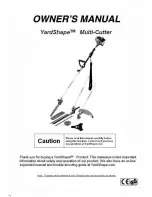
5.7
Basic Settings to select basic frequency
1) Switch off instrument.
2)
Switch on instrument and simultanly press key
(5).
3)
Stopp pressing key
(5) if all segments are displayed.
4)
Now select the basic frequency via switch(10)
To leaf the manual mode switch off and switch on the instrument.
5.8
Crest Factor (C.F.)
1)
Turn selector switch (3) to "~mA, ~A oder ~V"
2) Select basic frequency via switch(10).
3)
Select ”C.F.” vie key FUNC (6)
4)
at ~mA and A measurement
1) Open the clamp, and close it round the conductor. Make sure that the clamp pro-
perly encircles the conductor, and that there is no air gap between the jaws. For
best measurement results and highest accuracy, have the conductor placed in
center of clamp jaws.
at ~V measurement
1) Plug the black test lead into the "COM" socket and the red lead into the "V
Ω
"
socket
2) Connect the probes to the UUT and read the display
The crest factor (CF) is defined as following: CF = (peak value / RMS value)
5.9a
True RMS Measurement / Crest Factor
True RMS Measurement:
Conventional current clamps indicate the mean value and, therefore, are only appropria-
te for DC currents/voltages and pure sinus-shaped AC currents/voltages.
If the AC current/voltage is not sinus-shaped, e.g. caused by distortions due to a phase
control, a true RMS measurement must be carried out. The UNITEST clamp CHB 5 is suit-
able for true RMS measurement. The table shows the comparison between the UNITEST
clamp CHB 5 with true RMS measurement and current clamps with mean value and peak
value sampling.
11
PTDB93570002.qxd:Layout 1 30.05.2008 15:05 Uhr Seite








































